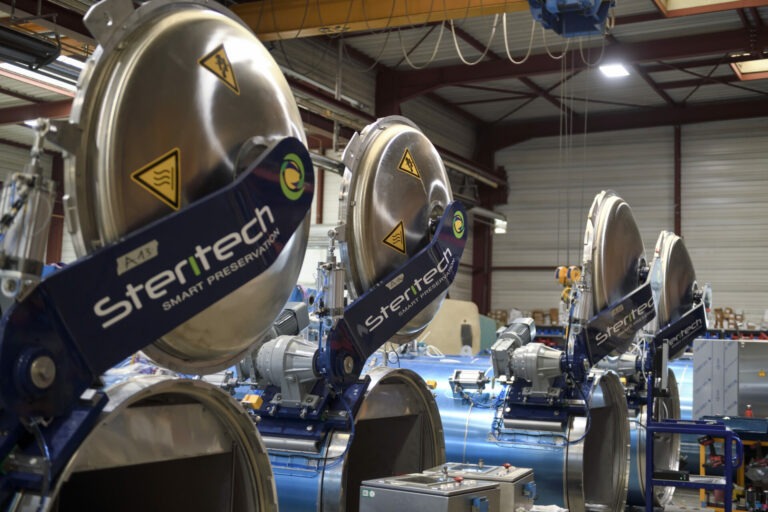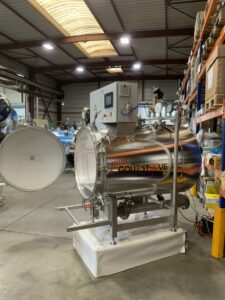
How to calculate sterilization time in industry?
How to calculate sterilization time in industry? Consideration of the time-temperature relationship is essential to ensure proper sterilization. In addition, the use of biological reference indicators is critical. These are a population of microbial that are resistant to sterilization. By measuring the time it takes to destroy them, we can define the sterilization time required for a given product and sterilizer.
Sterilization time: definition
Sterilization time is the duration of treatment required to eliminate a population of pathogenic microorganisms. These are mainly viruses, bacteria and spores present on and in a product, as well as in its packaging. This sterilization time ensures food safety and proper preservation.
Several sterilization technologies are available:
- destruction of microbial population by heat diffusion (water, pressurized steam, autoclave or continuous);
- destruction of microbial population by gamma or X-rays;
- destruction of microbial population by ethylene oxide gas.
Steritech autoclaves treat products by heat diffusion through steam or hot water. How to calculate sterilization time in industry is detailed here.
Method used to calculate the sterilization time
The sterilization of canned goods or food follows a mathematical logic. It is governed by two laws of decay of the number of microbial population as a function of time.
The sterilization time used is that corresponding to “effective” sterilization. Heat treatment efficiency is measured as the number of decimal reductions in microbial load (divided by 10).
To simplify calculations, the industry uses the sterilization value F0, which we’ll explain below.
A biological indicator of food sterilization is Clostridium botulinum. This is a bacterium whose spores are very resistant to heat.
Laws of microorganism decay
The first sterilization law measures the elimination of microbial population as a function of time. It expresses the time (DT) required for the process to reduce the number of microorganisms by a factor of 10 (one log) at constant temperature T.
The second sterilization law quantifies a change in temperature (z). It measures the additional temperature required to reduce the heat treatment time by one log. This data estimates the resistance of microbial population to temperature changes.
For most molds and bacteria, “z” varies from 6 to 14°C, generally settling at around 10°C. In practice, this means that increasing “z” by 10°C reduces sterilization times by a factor of 10.
These observations show that the reduction of microorganisms by heat treatment follows an exponential decay curve.
There is a formula for this decimal reduction tome called DT:
DT = t/(log10N0 – log10N)
Where :
N0 => number of microorganisms present in the product at time t=0;
N => number of microorganisms at time t (after treatment).
Let’s illustrate with some examples applied to Clostridium botulinum type A in the following table:
| Decimal reduction time DT | Sterilization time required |
| D121 | 0,21 minutes |
| D111 | 2,21 minutes |
| D131 | 0,021 minutes |
| D115 | 0,84 minutes |
The formula used is: DT + DTref x 10 (To -T)/z. Knowing “z” (10°C) and aDT0 value, the appropriate DT value can be calculated for each Clostridium botulinum Type A elimination temperature.
Explanation of F0 Sterilization Value
To compare the intensity of heat treatments, the industry uses the sterilization value. In Europe this is known as VS. It refers to heat treatment performed at temperature above 100°C. In North America publications, the sterilization value is referred to as F.
When referring to pasteurization value, it is denoted as PV (Pasteurization Value). It concerns heat treatment applied at less than 100°C.
In technical terms, the sterilization value reflects the intensity of the heat treatment applied to a product. A cumulative value expressed in minutes, the sterilization value is the thermal history of the treatment. Its profile is the time-temperature relationship.
Detailed calculation of sterilizing value F
The sterilization value measures the intensity of the heat treatment. This treatment is governed by regulations that define it as a means of “destroying or totally inhibiting, on the one hand, enzymes and, on the other hand, microorganisms and their toxins” (technical instruction no. 2015-364 DGAL/SDSSA).
The formula for the sterilization or pasteurization value is as follows:
VS or VP = ∫t010 (T-Tref)/z.dt
With the following values:
t => duration of the heat treatment;
T => product temperature for the duration of the treatment;
Tref => reference temperature for the calculation;
z => previously defined (temperature difference).
The following temperatures are commonly used by manufacturers:
| Reference temperatures in °C | Type of heat treatment |
| 121,1 | Sterilization of canned foods and non-acids products (pH less than or equal to 4.5) |
| 93,3 | Pasteurization of acid products (pH more than or equal to 4.5) |
| 70 | Pasteurization of non-acid products with BBD and cold storage |
Using the sterilization value
The VS or F0 value is used to obtain time/temperature combinations for sterilization at identical values. These different pairs apply to both autoclave and continuous sterilization. The table below shows an example of four time/temperature combinations to be applied to the product core to obtain a VS or F0 of 3 min:
| Temperature in °C | Time in min |
| 110 °C | 38,6 min |
| 115 °C | 12,2 min |
| 121,1 °C | 3 min |
| 125 °C | 1,2 min |
What does the first temperature/time pair mean? It means that reaching 110°C at the core of the product and maintaining this core temperature for 38.6 minutes to obtain F0 of at least 3 minutes. To obtain the same sterilization value in a shorter time, it is possible to increase the temperature with a core temperature of 121°C, it is only necessary to maintain the temperature for 3 minutes to obtain the sterilization value of 3 minutes.
Sterilization controls during the process
In order to determine if heat treatment is appropriate, in-process monitoring is required. This involves
Autoclaves equipped with temperature probes can perform this operation automatically. Depending on the control system used, the unit switches to cooling when the sterilization value is reached.
Validating the sterilization process using controls and samples
There are two ways to verify that a product or preparation has undergone the sterilization process:
- Physicochemical controls: heat-sensitive strips to be applied to products or their packaging (do not check that the heat treatment is suitable for the product). This control is performed during the cycle and verified at the end of the cycle;
- PH measurement inside cans using a stability measurement plan:values different from the control indicate microbial contamination (standards vary according to the product). These analyses are performed after the cycle and must be carried out according to a well-defined stability analyses plan.
Sterilization verification by comparison
It is also possible to validate a thermal sterilization process by comparison. This involves the use of biological controls, such as a sample of the heat-stable reference microorganism after treatment.
- Initial concentration level of the reference microorganism
- Final concentration level of the reference microorganism
The final concentration expresses the probability of survival of the microorganism. It must be much lower than the initial concentration.
Why calculate sterilization time in industry?
In short, the sterilization time is a thermobiological function used to determine the sterilization time at a given temperature. It indicates the number of minutes required to eliminate microorganisms.
It can be used to parameterize automatic sterilizers. It is a means to generate significant energy savings over a complete production cycle.
Steritech provides optimized sterilization solutions. We reduce sterilization times by 25%. In autoclave or continuous sterilization, your product will comply with current regulations. To learn more, contact us at +33 388 710 433 or via our contact form.
Other STERITECH news


Steritech: industrial sterilization for export

